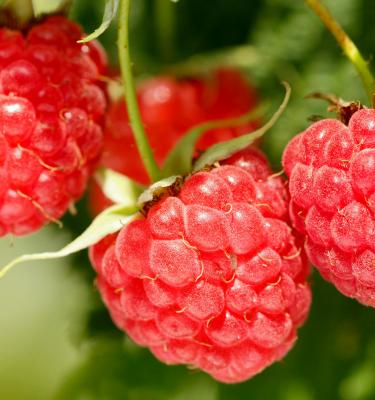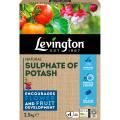

How to grow raspberries
What could be better than a bowl of sweet, freshly-picked raspberries in summer? These delicious fruits are easy to grow in a sunny garden, and if you’re short on space you can even grow raspberries in a pot. Enjoy them fresh in summer and autumn, and freeze them for use in winter pies and tarts.
Varieties of raspberry
Raspberries (Rubus idaeus) are divided into summer-fruiting and autumn-fruiting types. Autumn-fruiting varieties are a good choice for novice gardeners, as they are less prone to raspberry beetle (a pest that eats the fruit) and are also easier to prune than summer-fruiting types. Here are some of the most popular varieties:
Summer-fruiting raspberries
- ‘Malling Promise’ – vigorous plant with abundant big sweet berries
- ‘Glen Moy’ – heavy crops on almost spine-free canes
- ‘Glen Ample’ – lots of big, succulent raspberries
- ‘Glen Fyne’ – one of the best varieties for flavour
Autumn-fruiting raspberries
- ‘Autumn Bliss’ – compact, ideal for containers
- ‘Autumn Treasure’ – large sweet fruit on spine-free canes
- ‘Fall Gold – Large yellow fruits with exceptional flavour
What you’ll need to grow raspberries
- Secateurs
- Gloves
- Raspberry plants
For planting raspberries in the ground:
- Garden fork
- Garden spade
- Soil conditioner or well-rotted farmyard manure
- Slow-release fertilizer e.g. fish blood and bone
For summer-fruiting raspberries:
- Wooden posts 2.4m (8ft) long
- Wire
For growing raspberries in containers:
- 60cm (2ft) diameter container
- Soil-based compost
- High-potash feed
How to grow raspberries
Raspberries do best in a soil that is moist but well-drained and slightly acidic. If your soil is alkaline, you will have more success growing raspberries in pots rather than in the ground.

- Plant raspberry canes in autumn or winter in a sunny, sheltered spot, about 50cm (20in) apart, in rows spaced 1.5-2m (5-6ft) apart.
- Before planting, dig the soil over to clear it of weeds and stones, and dig in plenty of soil conditioner or well-rotted farmyard manure to improve the soil structure.
- Provide a support framework for summer-fruiting raspberries (autumn-fruiting raspberries are generally self-supporting), To make the support framework, knock sturdy 2.4m (8in) high posts into the ground at the end of each row and stretch 3 rows of heavy-gauge wires between the posts, spaced about 60cm (2ft) apart.
- Dig a trench 45cm (18in) wide and 20-25cm (8-10in) deep and cover the base with a good layer of organic matter, such as compost or well-rotted farmyard manure.
- Plant the canes, allowing 45cm (18in) between each cane. Add a handful of slow-release fertilizer such as fish, blood and bone when planting each cane.
- Backfill the trench with soil mixed with organic matter. Gently firm in around the roots and water in well.
- Cut the canes down to 25cm (10in) above ground level, to encourage them to produce plenty of fruit-bearing shoots.
Growing raspberries in pots
- Choose a large container, at least 60cm (2ft) in diameter.
- Fill the container with a soil-based compost such as John Innes no 3.
- Plant up to six raspberry canes per pot, spaced equally around the edge of the pot.
How to care for raspberries
Tie the canes of summer-fruiting raspberries to the wires with soft twine as they grow.
Water plants in dry periods, and water container-grown plants regularly to prevent the compost from drying out. Feed container-grown plants fortnightly with a high potash feed like Tomorite once the fruits start to develop.
Keep the plants clear of weeds. If using a hoe, take care not to damage the roots just below the surface of the soil.
How to prune raspberries
Prune summer-fruiting raspberries after the last fruit has been picked. Cut down all the dark brown canes that produced fruit to ground level. New canes that grew in the current year will fruit in the following year; retain the strongest 6-7 new canes for next year’s crop.
To prune autumn-fruiting raspberries, cut all canes back to ground level in February.
Common raspberry pests and diseases
Raspberry cane blight
Raspberry cane blight is one of the most serious raspberry diseases. It is a fungal disease that causes canes to die back, turning dark brown and breaking easily.
- Remove and destroy any affected stems, cutting back below soil level.
- Water plants regularly and mulch to reduce drought stress, which can make plants more prone to infection.
Raspberry beetle
Raspberry beetle affects mainly summer-fruiting raspberries as well as some early-flowering autumn varieties. Adult beetles lay eggs on the flowers and the larvae burrow into the developing fruits and eat them. Affected fruits develop dry patches around their stalk, and white maggots will be found inside the fruit.
- Plant autumn-fruiting varieties, which are less affected.
- Encourage natural predators like birds, hedgehogs and ground beetles.
- Pyrethrin sprays should not be used when plants are in flower to avoid harming pollinators, so are not practical against raspberry beetle.
Key features of raspberries
| Flowering season(s) | Spring, Summer |
|---|---|
| Foliage season(s) | Spring, Summer, Autumn |
| Sunlight | Full sun |
| Soil type | Clay, Loamy |
| Soil pH | Neutral |
| Soil moisture | Moist but well-drained |
| Ultimate height | Up to 1.8m (6ft) |
| Ultimate spread | Up to 30cm (1ft) |
| Time to ultimate height | 1 year |




